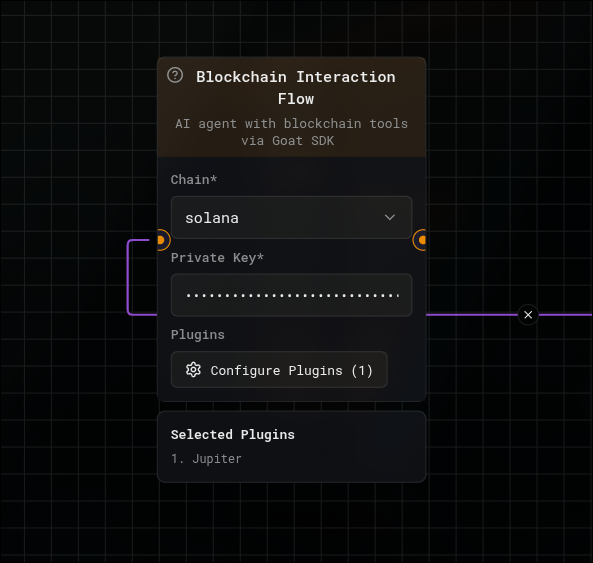Flows

Flows are the core orchestrators within the SkynetXBT system. They define sequences of actions, manage state, handle user interactions, and coordinate tasks performed by agents and plugins.
Quick Navigation:- Flows Store - Access and discovery hub
Overview
Flows act as the coordination layer between different components of the SkynetXBT framework. They can be executed in two modes:
- Interactive Mode: Triggered by user input or system events
- Autonomous Mode: Running independently in the background at scheduled intervals
Available Flows
🔗 DeFi Integration Flows
DeFi Llama Flow
Analytics and tracking for DeFi protocols
- Purpose: Protocol statistics and market analysis
- Capabilities: TVL tracking, yield analysis, protocol comparison
- Use Cases: Market research, investment decisions, protocol monitoring
Beefy Suggestions Flow
Intelligent yield farming strategy recommendations
- Purpose: Automated yield optimization suggestions
- Capabilities: Strategy analysis, risk assessment, APY calculations
- Use Cases: Yield farming optimization, portfolio diversification
⛓️ Blockchain Integration
Ethers Flow
Smart contract interactions using ethers.js with AI-powered function selection
- Purpose: Natural language smart contract interaction
- Capabilities: Contract deployment, function calls, transaction monitoring
- Use Cases: DApp development, contract testing, automated trading
📱 Communication & Notifications
Telegram Flow
Telegram bot integration for bidirectional communication
- Purpose: User interaction and notification system
- Capabilities: Message broadcasting, user commands, automated responses
- Use Cases: Community management, alerts, customer support
🤖 AI & Automation
General Agent Flow
Configurable LLM agent for various AI tasks
- Purpose: General-purpose AI processing and analysis
- Capabilities: Text analysis, data processing, conversational AI
- Use Cases: Content generation, data analysis, customer service
MCP Agent Flow
MCP protocol integration
- Purpose: Multi-chain protocol communication
- Capabilities: Cross-chain messaging, protocol integration
- Use Cases: Multi-chain applications, protocol bridging
🔧 Utility Flows
Fetch Flow
HTTP requests and data fetching
- Purpose: External API integration and data retrieval
- Capabilities: REST API calls, data parsing, response handling
- Use Cases: Price feeds, external service integration, data collection
Webhook Flow
Webhook handling and HTTP endpoints
- Purpose: External system integration via webhooks
- Capabilities: Event handling, HTTP server, data processing
- Use Cases: Third-party integrations, event-driven automation
Timer Flow
Scheduled task execution
- Purpose: Time-based automation and scheduling
- Capabilities: Cron-like scheduling, periodic tasks, delayed execution
- Use Cases: Automated monitoring, periodic reports, scheduled operations
Parser Flow
Data parsing and transformation
- Purpose: Data format conversion and extraction
- Capabilities: JSON/XML parsing, text extraction, data transformation
- Use Cases: Data processing, format conversion, content extraction
Coming Soon 🚧
The following flows are currently in development and will be available soon:
🔗 DeFi Integration
Arcadia Finance Flow
Yield optimization for Arcadia Finance on Base chain
- Purpose: Portfolio optimization and yield farming strategies
- Capabilities: Analyze positions, calculate yields, suggest optimizations
- Use Cases: DeFi portfolio management, yield farming automation
- Status: In development
🔍 Research & Analysis
Hyperbrowser Research Flow
Automated web research and data extraction
- Purpose: Web scraping and research automation
- Capabilities: Web crawling, data extraction, content analysis
- Use Cases: Market research, competitive analysis, data mining
- Status: In development
How to Use Flows
Flows are designed to be used programmatically through the flows store. Each flow accepts input through a standardized context and returns processed results.
Basic Usage Pattern
- Input: Provide your query or data to the flow
- Processing: The flow handles the task automatically
- Output: Receive results in text, JSON, or other formats
Integration with Agents
Flows can be used individually or combined with agents for more sophisticated automation. Agents intelligently route requests to appropriate flows based on user intent.
Flow Configuration
Many flows accept configuration options through environment variables for API keys, endpoints, and other settings. Check individual flow documentation for specific requirements.
Next Steps
- Flows Store - Learn about flow access and package management
- Individual Flow Pages - Click any flow name above for detailed documentation